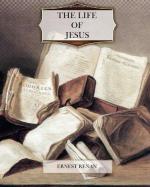[Footnote 1: Mark vii. 4; Jos., Ant., XVIII. v. 2; Justin, Dial. cum Tryph., 17, 29, 80; Epiph., Adv. Haer., xvii.]
[Footnote 2: Jos., B.J., II. viii. 5, 7, 9, 13.]
[Footnote 3: Mishnah, Pesachim, viii. 8; Talmud of Babylon, Jebamoth, 46 b; Kerithuth, 9 a; Aboda Zara, 57 a; Masseket Gerim (edit. Kirchheim, 1851), pp. 38-40.]
[Footnote 4: Matt. iii. 1; Mark i. 4.]
[Footnote 5: Luke iii. 3.]
[Footnote 6: John i. 28, iii. 26. All the manuscripts say Bethany; but, as no one knows of Bethany in these places, Origen (Comment. in Joann., vi. 24) has proposed to substitute Bethabara, and his correction has been generally accepted. The two words have, moreover, analogous meanings, and seem to indicate a place where there was a ferry-boat to cross the river.]
[Footnote 7: AEnon is the Chaldean plural, AEnawan, “fountains.”]
[Footnote 8: John iii. 23. The locality of this place is doubtful. The circumstance mentioned by the evangelist would lead us to believe that it was not very near the Jordan. Nevertheless, the synoptics are agreed in placing the scene of the baptisms of John on the banks of that river (Matt. iii. 6; Mark i. 5; Luke iii. 3). The comparison of verses 22 and 23 of chap. iii. of John, and of verses 3 and 4 of chap. iv. of the same Gospel, would lead us to believe that Salim was in Judea, and consequently in the oasis of Jericho, near the mouth of the Jordan; since it would be difficult to find in any other district of the tribe of Judah a single natural basin in which any one might be totally immersed. Saint Jerome wishes to place Salim much more north, near Beth-Schean or Scythopolis. But Robinson (Bibl. Res., iii. 333) has not been able to find anything at these places that justifies this assertion.]
[Footnote 9: Mark i. 5; Josephus, Ant., XVIII. v. 2.]
The people took him for a prophet,[1] and many imagined that it was Elias who had risen again.[2] The belief in these resurrections was widely spread;[3] it was thought that God would raise from the tomb certain of the ancient prophets to guide Israel toward its final destiny. Others held John to be the Messiah himself, although he made no such pretensions.[4] The priests and the scribes, opposed to this revival of prophetism, and the constant enemies of enthusiasts, despised him. But the popularity of the Baptist awed them, and they dared not speak against him.[5] It was a victory which the ideas of the multitude gained over the priestly aristocracy. When the chief priests were compelled to declare themselves explicitly on this point, they were considerably embarrassed.[6]
[Footnote 1: Matt. xiv. 5, xxi. 26.]
[Footnote 2: Matt. vi. 14; Mark vi. 15; John i. 21.]
[Footnote 3: Matt. xiv. 2; Luke ix. 8.]




